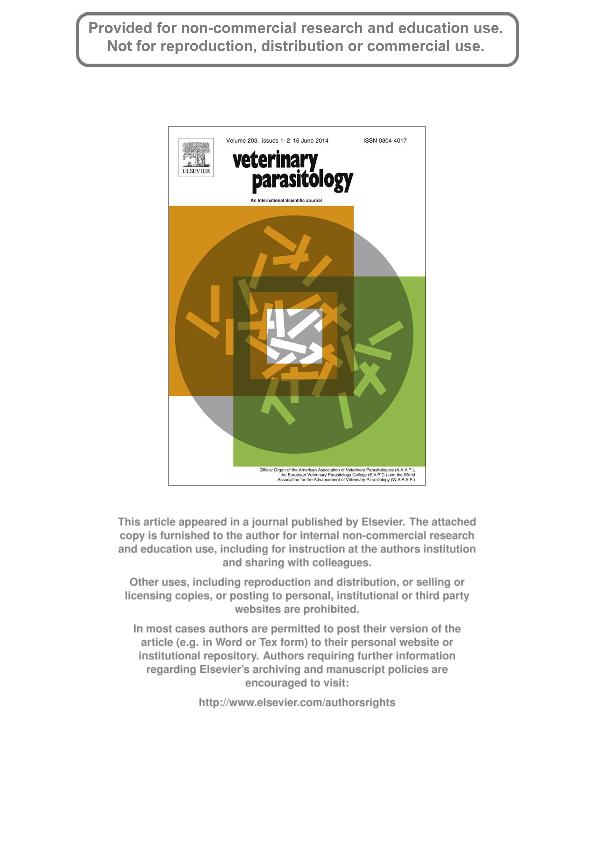Artículo
Accumulation of monepantel and its sulphone derivative in tissues of nematode location in sheep: Pharmacokinetic support to its excellent nematodicidal activity
Lifschitz, Adrian Luis ; Ballent, Mariana
; Ballent, Mariana ; Virkel, Guillermo Leon
; Virkel, Guillermo Leon ; Sallovitz, Juan Manuel; Viviani, Paula
; Sallovitz, Juan Manuel; Viviani, Paula ; Lanusse, Carlos Edmundo
; Lanusse, Carlos Edmundo
 ; Ballent, Mariana
; Ballent, Mariana ; Virkel, Guillermo Leon
; Virkel, Guillermo Leon ; Sallovitz, Juan Manuel; Viviani, Paula
; Sallovitz, Juan Manuel; Viviani, Paula ; Lanusse, Carlos Edmundo
; Lanusse, Carlos Edmundo
Fecha de publicación:
03/2014
Editorial:
Elsevier Science
Revista:
Veterinary Parasitology
ISSN:
0304-4017
Idioma:
Inglés
Tipo de recurso:
Artículo publicado
Clasificación temática:
Resumen
The amino-acetonitrile derivatives (AADs) are a new class of anthelmintic molecules active against a wide range of sheep gastrointestinal (GI) nematodes including those that are resistant to other anthelmintic families. The plasma disposition of monepantel (MNP) has been previously characterized in sheep. However, information on drug concentration profiles attained at tissues of parasite location is necessary to fully understand the pharmacological action of this novel compound. The current work aimed to study the relationship between the concentrations of MNP parent drug and its main metabolite monepantel sulphone (MNPSO2), measured in the bloodstream and in different GI tissues of parasite location in sheep. Twenty two (22) uninfected healthy Romney Marsh lambs received MNP (Zolvix®, Novartis Animal Health) orally administered at 2.5 mg/kg. Blood samples were collected from six animals between 0 and 14 days post-treatment to characterize the drug/metabolite plasma disposition kinetics. Additionally, 16 lambs were sacrificed at 8, 24, 48 and 96 h post-administration to assess the drug concentrations in the GI fluid contents and tissues. MNP and MNPSO2 concentrations were determined by HPLC. MNP parent compound was rapidly oxidized into MNPSO2. MNP systemic availability was significantly lower than that observed for MNPSO2. The peak plasma concentrations were 15.1 (MNP) and 61.4 ng/ml (MNPSO2). The MNPSO2 to MNP plasma concentration profile ratio (values expressed in AUC) reached a value of 12. Markedly higher concentrations of MNP and MNPSO2 were measured in both abomasal and duodenal fluid contents, and mucosal tissues compared to those recovered from the bloodstream. A great MNP availability was measured in the abomasal content with concentration values ranging between 2000 and 4000 ng/g during the first 48 h post-treatment. Interestingly, the metabolite MNPSO2 was also recovered in abomasal content but its concentrations were significantly lower compared to MNP. The parent drug and its sulphone metabolite were detected in the different segments of the sheep intestine. MNPSO2 concentrations in the different intestine sections sampled were significantly higher compared to those measured in the abomasum. Although MNP is metabolized to MNPSO2 in the liver, the large concentrations of both anthelmintically active molecules recovered during the first 48 h post-treatment from the abomasum and small intestine may greatly contribute to the well-established pharmacological activity of MNP against GI nematodes.
Palabras clave:
Monepantel
,
Gastrointestinal Tissues
,
Pharmacokinetics
,
Sheep
Archivos asociados
Licencia
Identificadores
Colecciones
Articulos(CIVETAN)
Articulos de CENTRO DE INVESTIGACION VETERINARIA DE TANDIL
Articulos de CENTRO DE INVESTIGACION VETERINARIA DE TANDIL
Citación
Virkel, Guillermo Leon; Sallovitz, Juan Manuel; Lanusse, Carlos Edmundo; Viviani, Paula; Ballent, Mariana; Lifschitz, Adrian Luis; et al.; Accumulation of monepantel and its sulphone derivative in tissues of nematode location in sheep: Pharmacokinetic support to its excellent nematodicidal activity; Elsevier Science; Veterinary Parasitology; 203; 1-2; 3-2014; 120-126
Compartir
Altmétricas



